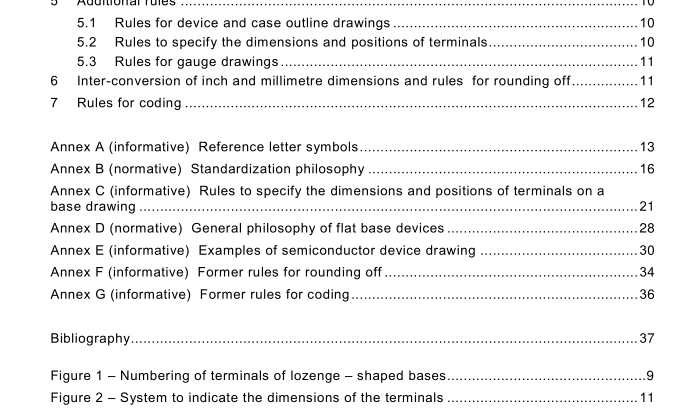BS IEC 60191-1:2007 pdf download – Mechanical standardization of semiconductor devices — Part 1: General rules for the preparation of outline drawings of discrete devices
c) Single minimum, single maximum or single nominal (where not given for general information) dimensions should be stated in decimals to such a number of places as is considered adequate to express the degree of accuracy appropriate for that dimension; e.g. if measurement to the nearest 0,001 mm is considered appropriate, the dimension should be expressed to the third decimal place (for example 0,500 mm), but if the measurement to the nearest 0,01 mm is sufficient, the dimension should be expressed to the second decimal place (for example 0,50 mm) and so on. Similar consideration should be given to the number of decimal places necessary when an original dimension is expressed in millimetres.
d) Limiting values or nominal value and limits of a toleranced dimension should be stated with the same number of decimal places (e.g. 0,01 6 mm min. – 0,01 7 mm nom. – 0,01 9 mm max.).
e) The use of fractional mm dimensions is permitted to describe nominal hexagon sizes.
f) Numerical dimensions should not be shown directly on the figure(s). They should be shown in tabular form under the figure(s) and correspond to the reference letter symbols on the figure(s). The letter symbols on the figure(s) should be upright. Upper case letters should be used for device outline and case outline dimensions and lower case letters for base dimensions. If confusion could arise, upper case letters should preferably be used throughout.
g) In the case of a diameter, the symbol “Ø” should appear in front of the reference letter concerned both on the figure(s) and in the table. In cases where the cross-section is uncontrolled (not necessarily round), the “Ø” symbol should not be used.
h) The table shall give dimensions in millimetres. The basic dimensions and system (millimetres or inches) will be indicated immediately above the table.
NOTE Outline drawings published in IEC 601 91 -2 before this document came into effect may give dimensions in inches.
i) The dimensions and limits which should normally be given and their corresponding reference letter symbols are contained in Annex A. Some examples of drawings prepared in accordance with these rules are given in Annex E. Where a particular reference letter is to be used for more than one dimension on the same drawing, use should be made of a suffix to identify the dimensions.
Annex A cannot be expected to include all dimensions likely to be necessary for mechanical standardization, more particularly in the future. A distinction has been made between primary and secondary reference letter symbols, primary reference letter symbols being those which are used most frequently, secondary reference letter symbols being those which are used less frequently and which can, if necessary, be associated with dimensions other than those given in the table.
j) Where it is self-evident that several angles are equal, it is not necessary to show more than one angle on the figure(s).
k) Notes will be numbered and placed under the table of dimensions, which will have a “notes”’ column on the right-hand side. The note reference will be placed opposite the dimension to which the note refers in the table or, when this dimension does not appear in the table, on the figure(s). The numerical sequence of the notes should follow the alphabetical sequence of the dimensional reference letters to which the notes refer. Notes referring to the figure(s) should follow notes referring to dimensions given in the table.
4.3 Methods for locating the datum These methods are listed below in order of preference. When more than one of these methods is possible for a given device, the method appearing earliest in the list should be used. When none of the following methods is possible, the method best suited to the device should be used.
